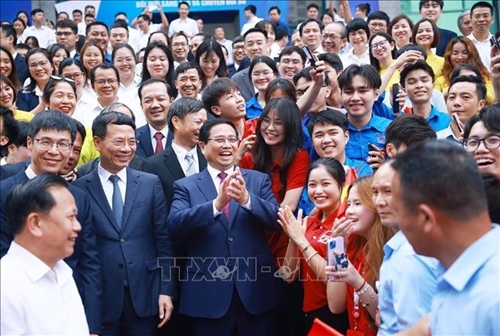    |
 |
|
Prime Minister Pham Minh Chinh and PTIT's leaders and students. |
PM Pham Minh Chinh requested the PTIT to take the lead in connecting the State, the school, scientists, and businesses and investors; in autonomy and commercialization of products; and in thinking big, acting bold, and daring to overcome one's own limits.
In the coming period, the institute should closely follow the situation, forecast global and national trends, and set clear development goals, tasks, and solutions that create synergy, he stated, stressing that the trend of peace, cooperation, and development remains the main flow of the era.
In today's world, where situations evolve rapidly and unpredictably, no country, not even a major power, can solve problems alone. Therefore, it is essential to follow this flow, accelerate to keep pace, advance together, and strive for progress. In this context, science, technology, and innovation are major global trends, and therefore, the institute must align with these trends, stressed PM Pham Minh Chinh.
The Government leader stressed that teachers must create motivation and inspiration for students. All school activities must be student-oriented, create opportunities for them to contribute to the institute, link study and work, and contribute to the whole nation’s efforts to develop the digital economy, digital society, and digital citizens.
The PTIT currently has two branches in Hanoi and Ho Chi Minh City, with four research institutes and one affiliated short-term training center, and around 25,000 students.
Currently, it is a leading university in digital transformation of higher education, and has built a digital transformation architecture with a complete digital university ecosystem, as all management activities, and student support services are performed on a smart phone application with a single "touch point."
In the 2025-2030 period, the institute continues to focus on quick and quality human resources training for strategic technology fields such as artificial intelligence (AI) and Big Data, semiconductor, new generation telecommunications networks, and low-altitude satellites. It also aims to form a national startup incubation center and become a national technology transfer center in key areas and a hub for high-quality personnel training and research.
Source: VNA